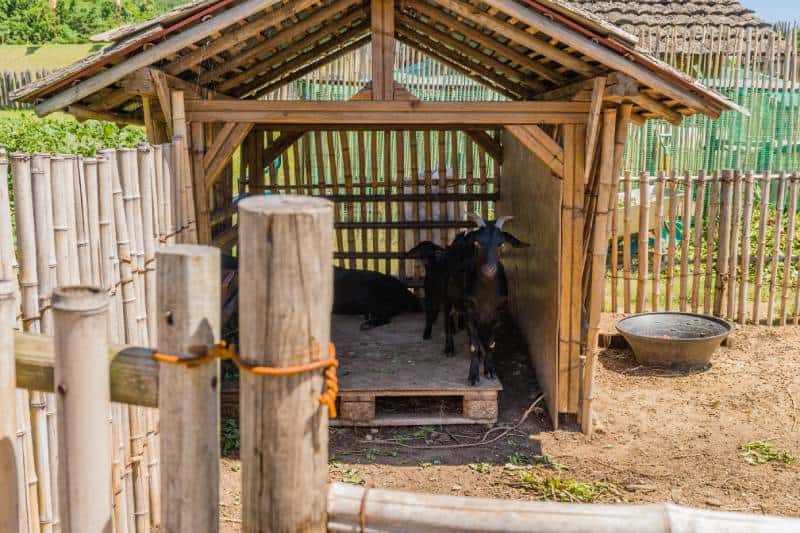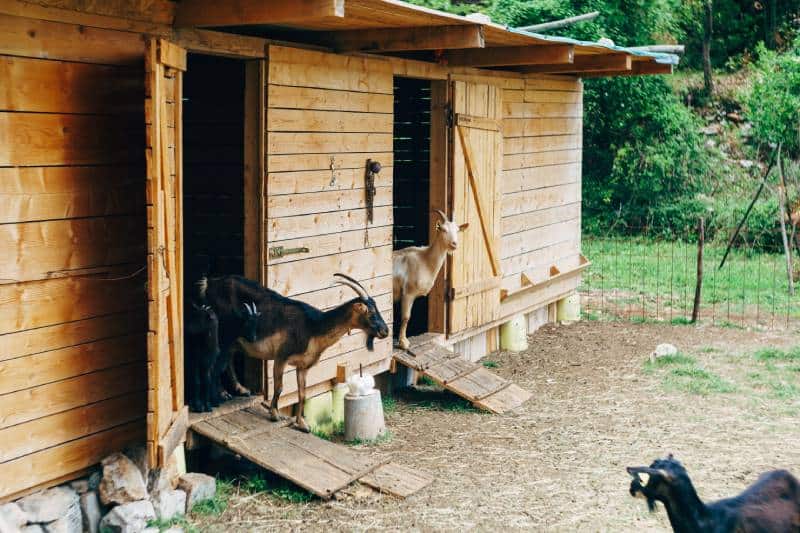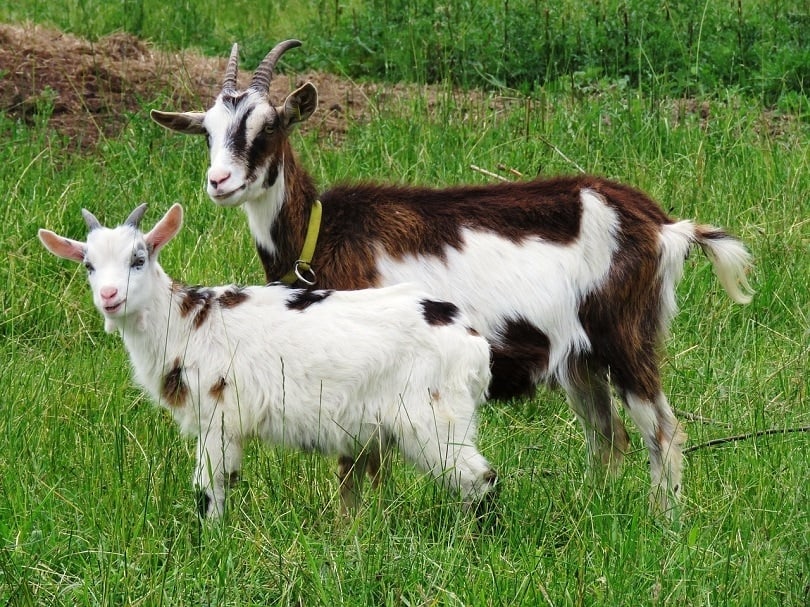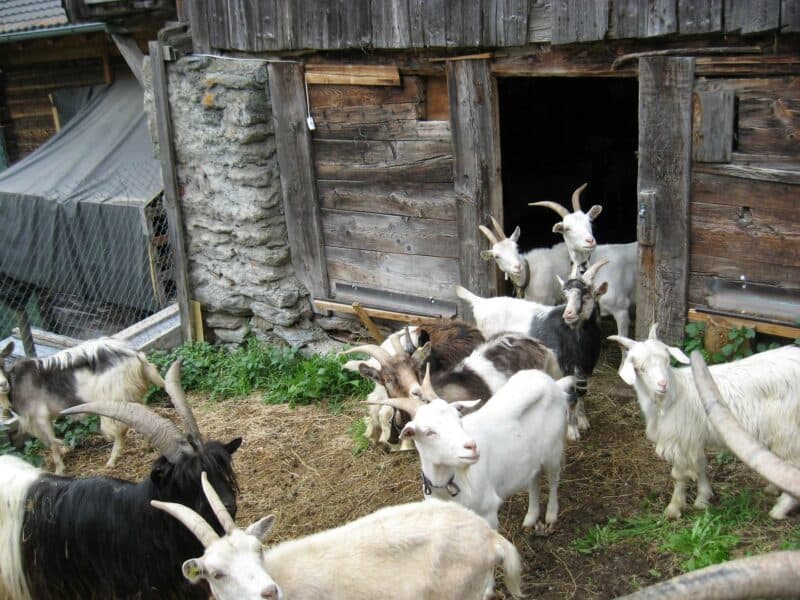Approved by Dr. Luqman Javed
Classic barnyard animals are becoming increasingly popular pets. Goats are often the star of this farm stock turned beloved pet movement. Their goofy personalities are adored by many, but as they are a less conventional pet, their care requirements are less commonly known – for example, that goats need shelter!
While goats are incredibly hardy animals that can tolerate a great range of conditions, sufficient shelter is a vital part of goat husbandry to help keep goats dry, warm, and healthy. There are multiple different ways to provide shelter, but, good news, the simplest forms are easy and inexpensive.

Why Shelter is Important for Goats
A well-cared-for goat will have a lovely thick coat that will keep them protected from the elements. But even so, they will seek shelter from the rain, wind, sun, and hot sun. In the wild, they would find shaded areas by rocks or trees to offer this shelter, but when kept as pets, this shelter needs to be provided.
Without adequate shelter, your goat can be overexposed to the elements. Continued exposure to cold, wind and wet conditions can risk developing respiratory illnesses or hypothermia. Prolonged exposure to the hot sun can also increase the risk of your goat getting heatstroke.
Shelters can protect your goat from these harmful elements. Providing shelter offers a choice for your goat to express healthy behaviors. With the right environment, they will manage their comfort and seek refuge in poor weather.
The 2 Types of Goat Shelters
1. Open

An open shelter can range from a simple roofed structure to a 3-sided shed. This type of shelter is often the most popular choice. They are simple to build and relatively cheap, and they require little materials or labor. Even the most inexperienced builders can erect an open goat shelter with little effort.
In addition to being affordable, the open design makes cleaning a breeze. It is easy for you to access and remove old bedding or add new substrate. It’s accessible for both you and your goat, as they can move freely from the shelter and the paddock.
The open design also makes for excellent natural ventilation. Air will circulate through the open shelter and keep things fresh and dry. The only downside is that bedding needs to be frequently added as bedding will be lost in an unconfined shelter.
- Inexpensive
- Easy to clean
- Goats can move freely
- Great air circulation
- Bedding needs to be added frequently
- Predators can easily enter the enclosure
2. Closed

Use of a closed shelter for a goat is excellent if you live in an area with extreme cold or wet conditions. A closed shelter is essentially a barn. It will provide better protection from the elements than an open structure.
A closed structure will also make it easier to manage your herd if you have multiple goats. They can be separated, if need be, for example, if you have a pregnant goat or one goat is being bullied.
While there are only a couple of pros, they are vital ones, so they may influence your choice of shelter. The closed shelter is more work as access to the area to clean is harder, your goats will need to be let out to exercise, and the shelter will need specialized ventilation. These types of shelters are also more expensive.
Some closed shelters will have attached exercise areas that they can open into.
- Protects goats from extreme weather
- Easier to manage individual goats
- More expensive
- More work to clean out
- Goats need to let out for exercise
- Needs more sophisticated ventilation
- Offers protection from predators
Choosing the Best Shelter for Your Goat
For the most part, a simple open shelter is all that is required for most pet goats. But there are some things you should consider when choosing the type of shelter best suited for your goat and your home.

- Climate – if you live in a place that experiences extreme weather, such as very low or high temperatures or regular snow, you may need to provide more shelter than a simple covered area.
- Your property – an open shelter only works if it is in an adequately contained pasture. Your goat still needs to be contained and secure for them to be safe. If you are using a closed shelter, then they may not need such vigorous fencing.
- Age/life stage – goats of various ages and stages may be more sensitive to environmental conditions. For example, very young or elderly goats may be more vulnerable to becoming ill due to lower immune systems.
- Social structure – if you have multiple goats, then you need to consider the relationship between them. For a small open shelter, a dominant goat may keep other goats away. Multiple open shelters can be used; otherwise, a closed shelter can keep goats separated.
- Your resources – the type of shelter you use will have different maintenance requirements. Make sure the shelter you chose fits with the time and tools you have to clean it.
Goat Shelter: Our Best Tips
- You can use a combination of an open and closed shelter so it can adapt to your changing needs and the alternation of the seasons. This may be more complicated and expensive but can result in the best care.
- Don’t tether your goat. Tethering is often used to contain goats who have a tendency to escape. Tethering can cause entanglement and vulnerability to the elements and potential animal attack. It’s better to invest in better fencing than to tether your goat!
- If using an open shelter, consider the positioning of the open side of the structure. Face it away from the prevailing wings of your area.
- Provide bedding in your shelter to add comfort, warmth, and increased hygiene for your goat. Pine shavings or hay make great bedding.
- Keep feed and water separate from the bedding area. If nearby, there is a higher risk of contamination from fecal matter.
- Keep bedding dry and fresh. In an open shelter, you can create a “bedding pack,” in which you add fresh bedding on top of older bedding. Ensure that the top bedding is clean and dry and regularly clean out all bedding.
- Consider windows in a closed shelter structure. It will allow sunlight to provide your goats with vitamin D and help keep the space dry and warm. It will allow sunlight and better ventilation. Be warned though: goats are remarkable jumpers and might be able to escape through an open window if it’s large enough.
- Ensure great ventilation of closed shelter. Gasses from manure and bedding can build up in stagnant air. Improper ventilation also can cause mold and excessive moisture, which contributes to respiratory illnesses.

Final Thoughts
Your pet goat will bring you endless joy and entertainment. However, they do tend to be relatively high maintenance in care. Part of excellent husbandry for them should include shelter that will provide them a temperature and a dry place to rest.
When considering your goat shelter, find an option that works well for both your goat’s health and well-being and something that will be accessible and efficient for you to maintain.
Featured Image Credit: picturemaker123, Pixabay
